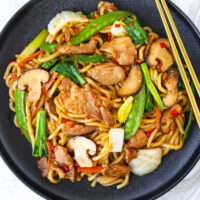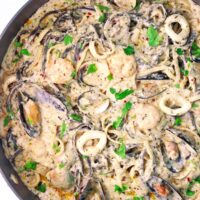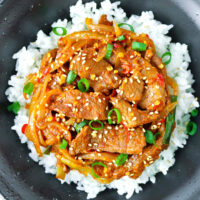Shanghai Style Fried Noodles
This post contains affiliate links.
Shanghai Style Fried Noodles is made with chewy thick noodles, juicy pork slices, garlic, chilies, mushrooms, cabbage, other veggies and stir-fried in a mouthwatering savory-sweet sauce! It’s quick and easy to make in 25 minutes, customizable with your favorite protein and veggies, and perfect for busy weeknights!
Shanghai Style Fried Noodles (Shanghai Cu Chao Mian – 上海粗炒面) is a popular dish found in restaurants all over Hong Kong and in Shanghainese restaurants. It’s a simple stir-fried noodles dish that’s super quick and easy to make on any given weeknight and deliciously addictive!
We have:
- Chewy and bouncy Shanghai noodles.
- Tender and juicy seared pork slices.
- LOTS of garlicky and fresh chili flavors.
- Delicious soft and crisp veggies like mushrooms, carrots, snow peas, cabbage, and choy sum.
- And everything gets stir-fried in a mouthwatering savory sauce with a hint of sweetness and fragrant toasted sesame aromas!
While Shanghai noodles are generally mild with savory-sweet notes, I like to make mine extra spicy with the addition of fresh red chilies and a splash of chili oil. However, as with most of my recipes, you can make this as spicy or as mild as you like. 👌
Try it once, and I think you’ll love it and be making it over and over again!
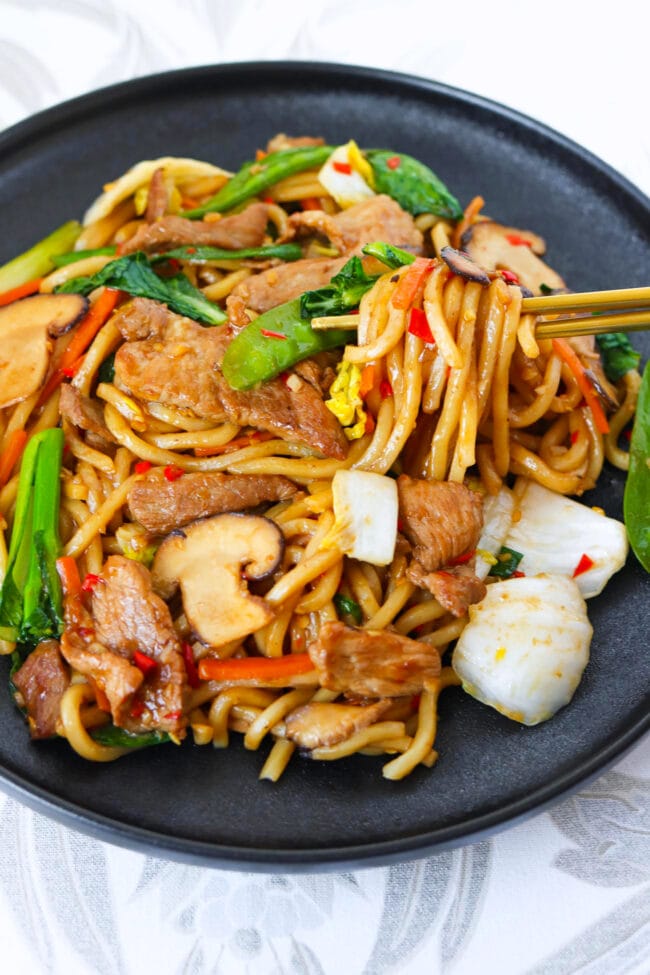
Why This Recipe Works
- Quick and easy to make. Everything gets tossed in a hot wok and is ready in just 25 minutes. Perfect for busy weeknights!
- Customizable. You can customize it with your choice of protein and veggies.
- Adjustable spice level. Amp up or tone down the heat level by adjusting the amount of spicy ingredients you use based on your heat level preference. It’ll be tasty either way!
- SO DELICIOUS! This Shanghai Style Fried Noodles is incredibly flavorful and so much better than takeout!
Ingredient Notes and Substitutes

- Pork Collar Meat: Typically, Shanghai style fried noodles is made with beef or pork in Hong Kong. I used pork collar as it has a good amount of fat running through it and results in tender and juicy pork slices after cooking. Feel free to use a lean cut of pork (e.g. tenderloin/fillet) if you prefer. Or you can use other meat or vegetarian proteins (see ‘Variations’ section below), or leave out the meat completely.
- Aromatics: Garlic, fresh red chilies, and spring onion (scallion/green onion). I used Thai Bird’s Eye chilies but you can use any small hot type of chilies that are easily available to you. Omit if you’d like to make this noodles stir-fry mild.
- Veggies: I used Asian brown mushrooms, Chinese cabbage (also known as wombok or Napa cabbage), choy sum, carrots, and snow peas. Asian brown mushrooms and Chinese cabbage are the common veggies used in Shanghai style fried noodles at restaurants and in Asia. Some versions will have carrots, Chinese yellow chives, bok choy, or onion too. However, you can use enoki, Shiitakes, rehydrated cloud or wood ears or any other Asian mushrooms you like. Feel free to throw in any stir-fry friendly veggies that need using up in your crisper drawer.
- Shanghai Noodles: These are thick wheat-based Chinese noodles that are white in color and have a wonderful chewy and bouncy texture. You can use fresh Shanghai noodles (available in the fridge section of Asian supermarkets) or use vacuum sealed packs of pre-cooked noodles like I did here. Dried noodles can be used instead too. Substitute with udon noodles – which have a similar thick and chewy texture – if unavailable.
- Ground White Pepper: Added at the end for a subtle peppery kick. Use more or less to taste.
- Canola Oil: Or use any other neutral cooking oil with a high smoke point.

- Low Sodium Light Soy Sauce: So that we can control the salt level better.
- Shao Xing Rice Wine: A fragrant Chinese cooking wine with a floral aroma. It’s an Asian pantry staple and used in marinades and sauces. Look for it in an Asian/Chinese supermarket.
- Potato Starch: Like corn starch, potato starch is used for marinades to create a lovely velvety coating on the meat and also as a thickening agent for sauces. We’ll be using it for both of these purposes in this recipe. You can use corn starch instead if you don’t have potato starch on hand.
- Dark Soy Sauce: This is mainly used to give the noodles a lovely dark reddish tint. It’s not as salty as regular light soy sauce. If you don’t have it on hand, use low sodium light soy sauce instead.
- Oyster Sauce: Contrary to what one might think, oyster sauce does not taste strongly of oysters. It’s a thick savory-sweet sauce that adds wonderful umami notes to these stir-fried noodles. It can be found in mainstream supermarkets that are well-stocked with international ingredients and Asian and Chinese supermarkets.
- White Sugar: Just a little to balance out the savory and spicy notes. Feel free to use less and to taste.
- Chili Oil (optional): This is a pure Chinese chili oil without any seeds or flakes. I add it to give the noodles an extra kick of heat! Feel free to leave it out if you’re not big on spice.
- Kosher Salt: Use half the amount if using iodized table salt.
Full ingredient list and amounts are in the recipe card below.

How to Make Shanghai Noodles with Pork
1. Prepare the noodles. If using vacuum sealed packs of precooked noodles, simply add them to a pot of boiling water and gently shake the noodle cake with tongs until the strands separate. Fresh noodles only need to be briefly boiled. Dried noodles should be cooked according to package instructions. Drain into a colander and run cold water on top to prevent sticking.
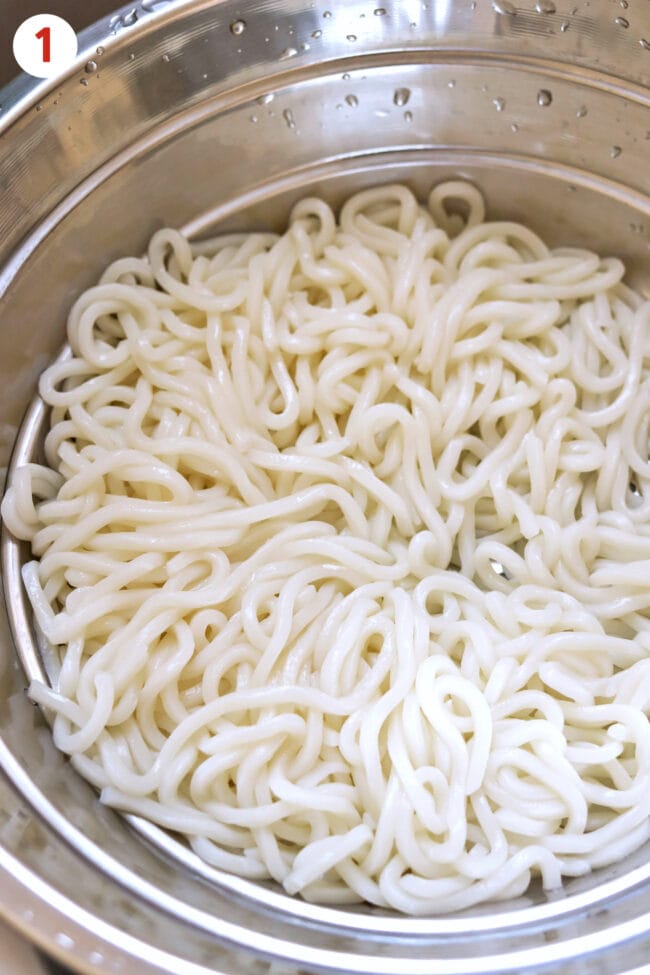
2. Cook the pork. Cook in a bit of oil in a large wok until nicely seared and almost fully cooked through. Transfer to a clean bowl using using a slotted spoon.
3. Sauté the mushrooms. Add more oil to the wok if needed and cook the mushrooms for half a minute until they start to soften.
4. Stir-fry the aromatics. Add the garlic, fresh red chilies, and spring onion white and light green parts and stir-fry until fragrant.
5. Stir-fry the carrots and snow peas. Toss for a few seconds to combine.

6. Add the pork, noodles and sauce. Stir-fry until everything is evenly coated in the sauce.
7. Stir-fry the cabbage, choy sum, and spring onion dark green parts. Sprinkle white pepper on top. Use a scooping motion to stir-fry until the veggies are slightly wilted but still have a little crunch to them. Switch off the heat.
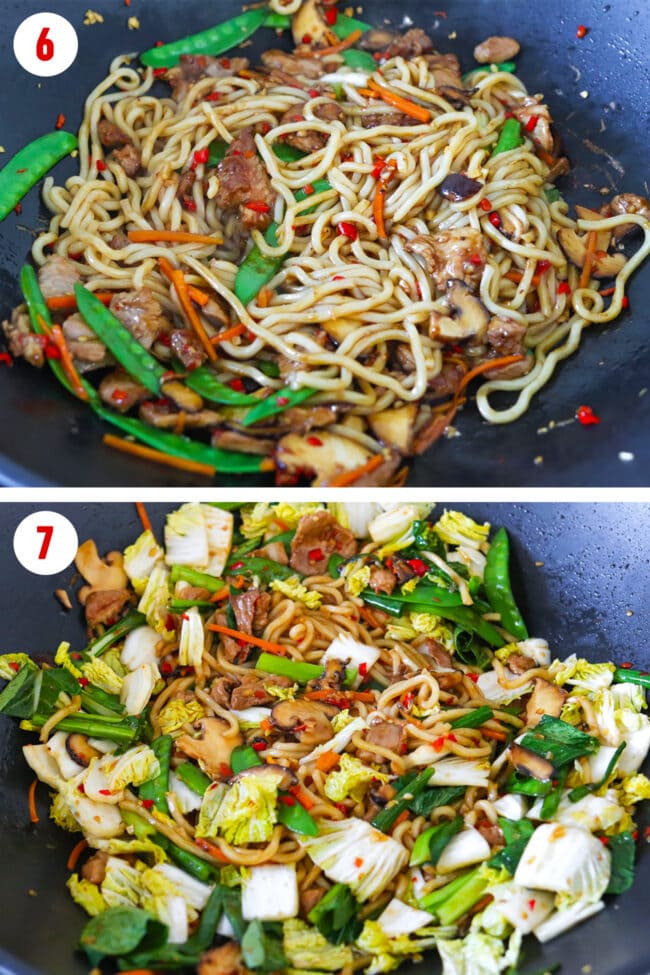
Serve! Divide evenly into plates or bowls. Then enjoy while hot, and with a drizzle of Chinese chili oil on top if desired.
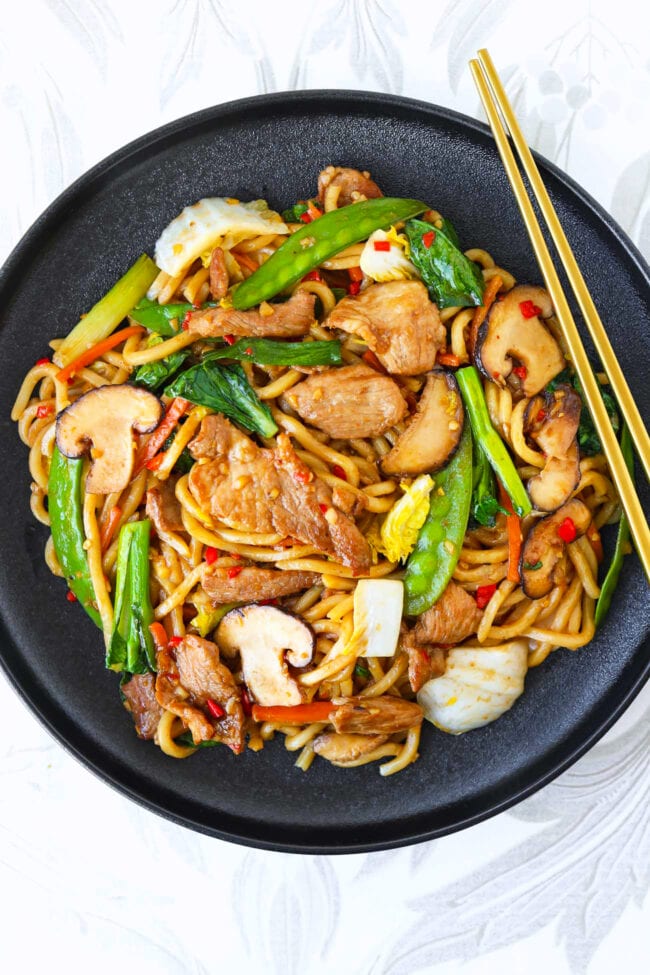
Full detailed instructions are in the recipe card below.
Cook’s Tips
- Prepare all the ingredients before you start cooking. This noodles stir-fry is ready very quickly and takes very little time to cook due to cooking over high heat. It’s best to have everything prepped and by the side of your wok before you start stir-frying.
- Use a large wok or deep heavy bottomed pan. A large cast iron or carbon steel wok is ideal and will give the noodles the signature wok hei (breath of the wok) that you find in restaurant dishes. That said, a large heavy bottomed frying pan too or a nonstick wok would work well as long you don’t overcrowd it.
- Cook in two batches if your wok or pan is not large. If your wok or pan isn’t large enough, cook in two batches. This will prevent overcrowding, which can cause the noodles to become gluggy and the veggies soggy.
- Add veggies that take longer to soften first. If customizing this with other veggies in your crisper drawer, vegetables that take longer to soften (e.g., onion, bell peppers, zucchini, sugar snap peas, etc.) should be added before adding the noodles and sauce. Leafy greens and softer veggies can be added at the end. This will ensure that they just slightly wilt and don’t become soggy.
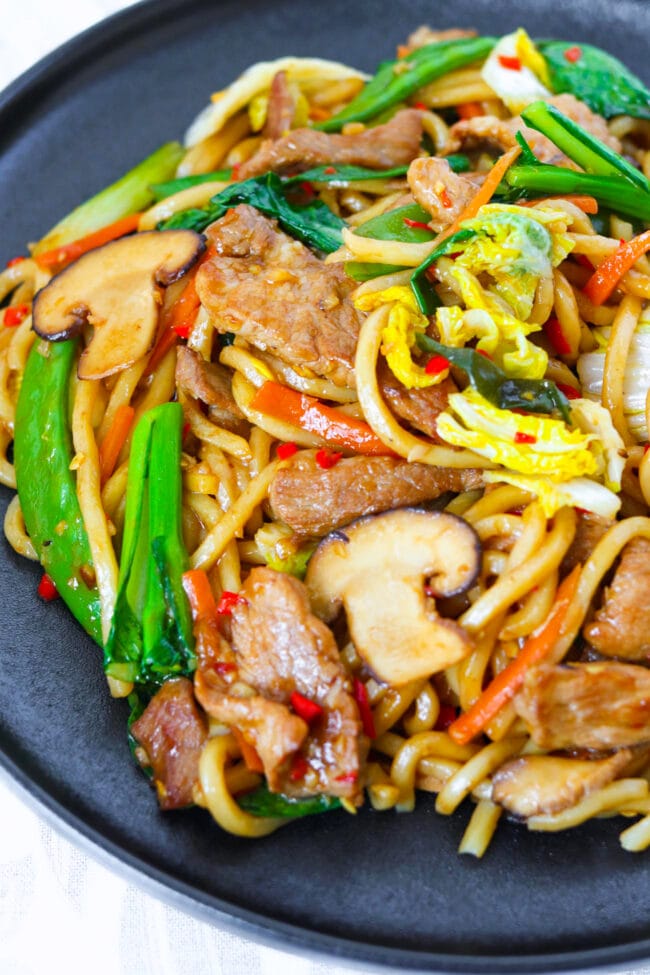
FAQs
Shanghai noodles are a thick noodle variety made primarily from wheat flour and water and are therefore not gluten-free.
Shanghai noodles are typically not spicy. However, you can make it spicy like I have by adding a few chopped fresh Thai Bird’s Eye chilies to the stir-fry and chili oil to the sauce. If you’d like to make it mild, simply leave out the spicy ingredients.
If using vacuum sealed packs of precooked Shanghai noodles which are in the form of noodle cakes, add them to a pot of boiling water and use tongs to hold the cake and gently shake in the water. The strands will separate easily this way within a minute or so. Drain into a colander and run cold water over the noodles to prevent them from cooking further and sticking. Then use as indicated for the recipe.
I do not recommend freezing Shanghai noodles because the texture of the noodles will be altered when thawing and become mushy. It tastes best when eaten immediately after cooking. That said, you can store leftovers in a sealed airtight container in the fridge for up to 3 days and reheat in the microwave for 2-3 minutes.
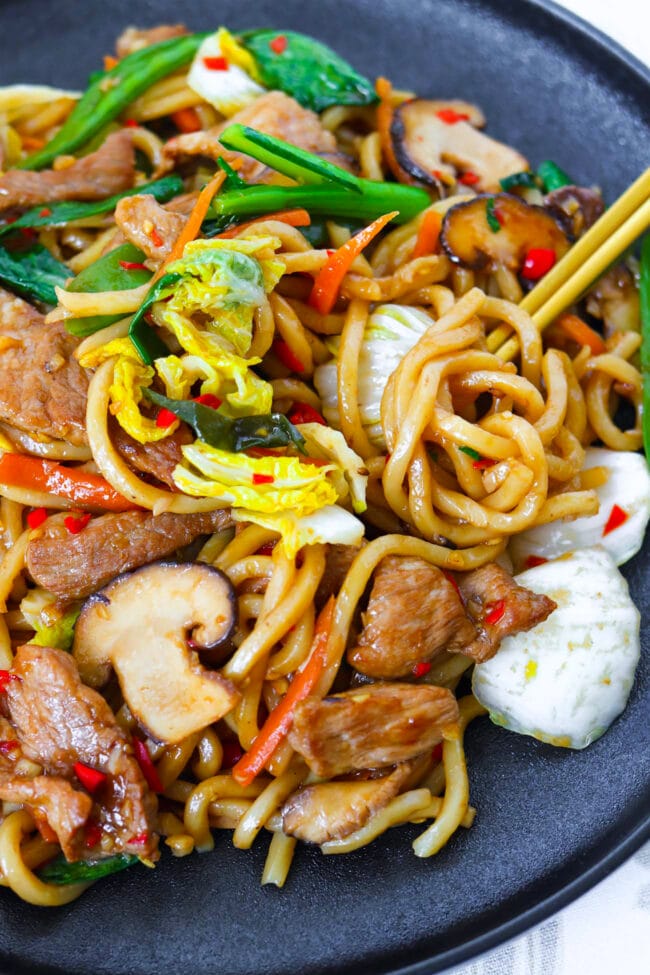
Variations
- Use a different protein. Thinly sliced boneless and skinless chicken breasts or thighs, beef flank or skirt steak, or shrimp/prawns can be used instead of pork.
- Make it vegetarian/vegan. Omit the pork and marinade ingredients. Alternatively, make some crispy pan-fried tofu cubes to toss in the noodles or use a plant-based meat substitute. Be sure to use a vegetarian mushroom flavored oyster sauce for the stir-fry sauce.
- Make it gluten-free. Use gluten-free udon noodles, rice vermicelli (mei fun), or other chewy thick gluten-free noodles. Also, use a gluten-free soy sauce and oyster sauce and dry sherry in place of the Shao Xing rice wine.

More Stir-fried Noodles You May Also Like
- Chicken Chow Fun
- Stir-fried Kimchi Chicken Noodles
- Stir-fried E-fu Noodles with Shrimp
- Sichuan Sauce Noodles Stir-fry
- Pad Mee Korat (Pad Thai’s spicier cousin!)
- Spicy Pork Pad Thai
- Or browse the entire Stir-fried Noodles and Noodles recipe collections.
MADE THIS RECIPE? If you make this recipe, leave a comment below and let me know how you liked it! Take a photo and tag it with @thatspicychick on Instagram and hashtag it #thatspicychick and I’ll be sure to share your masterpiece!
STAY CONNECTED! You can also follow me on Pinterest, Facebook or Instagram. Sign up for my email list to get my latest recipe in your inbox weekly!
PrintShanghai Style Fried Noodles
Shanghai Style Fried Noodles is made with chewy thick noodles, juicy pork slices, garlic, chilies, mushrooms, cabbage, other veggies and stir-fried in a mouthwatering savory-sweet sauce! It’s ready in 25 minutes and better than takeout!
- Prep Time: 15
- Cook Time: 10
- Total Time: 25 minutes
- Yield: 4 1x
- Category: Dinner
- Method: Stir-fry
- Cuisine: Chinese
Ingredients
For the Pork Marinade:
- 230 grams / 8.11 ounces Pork Collar Meat
- 2 TSP Low Sodium Light Soy Sauce
- 1 TSP Shao Xing Rice Wine
- 1 TSP Potato Starch (or Corn Starch)
- ¼ TSP Sesame Oil
For the Sauce:
- 1.5 TBLS Low Sodium Light Soy Sauce
- ½ TBLS Dark Soy Sauce
- ½ TBLS Shao Xing Rice Wine
- 1 TBLS Oyster Sauce
- 1 TSP White Sugar
- 1 TSP Sesame Oil
- 1 TSP Pure Chili Oil (optional – without flakes/seeds)
- 1/8 TSP Kosher Salt, to taste (see notes*)
For the Shanghai Style Fried Noodles:
- 5 Garlic Cloves – minced
- 2–10 fresh Red Chilies (Thai Bird’s Eye or any small hot red chilies), to taste – finely chopped
- 2 Spring Onion (Scallion/Green Onion) – cut into 1.5-inch pieces, white and light green parts separated from dark green parts
- 75 grams / 4 fresh Asian Brown Mushrooms (such as Shiitake) – rehydrated in bowl of water if using dried mushrooms, washed, pat-dried, thinly sliced
- 1.5 cups chopped Chinese Cabbage (Wombok/Napa Cabbage)
- 1 cup chopped Choy Sum (or other Asian Greens such as bok choy, Chinese broccoli – ‘gai lan’)
- ¼ cup julienned Carrots (about half of a small carrot)
- 50 grams / 1.75 ounces Snow Peas – ends trimmed and hairy parts removed
- 400 grams / 14 ounces pre-cooked Shanghai Noodles (or Udon Noodles – see notes*)
- 3 TBLS Canola Oil (or any other neutral cooking oil with a high smoke point)
- ¼ – ½ TSP ground White Pepper
- To Serve (optional): Chinese chili oil (with flakes/seeds – store-bought or homemade)
Instructions
Prep:
- Marinate the pork: Thinly slice the pork collar meat into strips. Add to a bowl, followed by the low sodium light soy sauce, Shao Xing rice wine, potato starch (or corn starch), and sesame oil. Mix well to combine. Set aside to marinate while you prepare the rest of the ingredients.
- Make the sauce: Whisk together the low sodium light soy sauce, dark soy sauce, Shao Xing rice wine, oyster sauce, white sugar, sesame oil, pure chili oil (if using), and kosher salt in a small measuring cup (for easier pouring) or bowl until combined well. Set aside.
- Prepare the fresh ingredients: Chop/prepare the garlic, fresh red chilies, spring onion (separate the white and light green parts from the dark green parts), mushrooms, Chinese cabbage, choy sum, carrot, and snow peas as indicated in the ‘ingredients’ section and set aside.
For the Shanghai Style Fried Noodles:
- Prepare the noodles: Bring a pot of water to a boil and add the noodles to the pot. Use tongs to grab onto the noodle cakes and gently loosen them up until the strands have separated and are tender – about 1 minute. Drain into a colander and run cold water on top to prevent sticking. Set aside. (See note 3 if using fresh or dried noodles.)
- Cook the pork: Heat 2 tablespoons canola oil in a large wok over high heat. Once hot, add the marinated pork and immediately spread out the pieces in the wok. Allow to sear for a minute, then stir-fry and allow to sear for another 30 seconds until almost fully cooked. Use a slotted spoon to transfer to a clean bowl. Remove and discard any crispy bits from the oil in the wok.
- Sauté the mushrooms: Add the remaining 1 tablespoon of canola oil to the wok and heat over high heat. Once hot, add the mushrooms and sauté for 30 seconds until starting to soften.
- Stir-fry the aromatics: Add the garlic, fresh red chilies, and spring onion white and light green parts and stir-fry for 20 seconds until fragrant.
- Stir-fry the carrots and snow peas. Add the carrots and snow peas and toss for 20 seconds to combine.
- Add the pork, noodles and sauce: Add the pork and toss briefly to combine. Then add the noodles and pour the sauce on top. Stir-fry and mix until everything is evenly coated in the sauce.
- Add the cabbage and greens: Add the cabbage, choy sum, and spring onion dark green parts and sprinkle ground white pepper to taste on top. Stir-fry continuously using a scooping motion until the veggies are slightly wilted but still have a little crunch to them. Switch off the heat.
- To Serve: Divide evenly into plates/bowls. Serve immediately while hot, and with Chinese chili oil on the side if desired.
Notes
- Pork Collar Meat. The fat that runs through the cut of pork collar makes the meat tender and juicy once cooked. However, feel free to use a lean cut of pork such as tenderloin/fillet if you prefer. Alternative protein options are thinly sliced boneless and skinless chicken breasts or thighs, beef flank or skirt steak, or shrimp/prawns. You can also use crispy pan-fried tofu cubes or a plant-based meat substitute to make this vegetarian. Be sure to use a vegetarian mushroom flavored oyster sauce for the stir-fry sauce if making this vegetarian/vegan.
- Vegetables. Feel free to customize this with other stir-fry friendly veggies you like. Some ideas are enoki mushrooms, cloud or wood ear mushrooms, sugar snap peas, Chinese yellow chives, yellow onion, bok choy, Chinese broccoli, etc.
- Shanghai Noodles. You can use fresh Shanghai noodles (available in the fridge section at Asian/Chinese supermarkets), vacuum sealed packs, or dried noodles. I used 2 x 200 grams / 7 ounce packs of vacuum sealed pre-cooked fresh Shanghai noodles. Udon noodles have a similar thick texture and can be substituted if unavailable. If using fresh Shanghai noodles, boil for 1-2 minutes only. If using dried Shanghai or udon noodles, you’ll need 200 grams / 7 ounces. Cook dried noodles according to package instructions. After preparing as needed, drain and run cold water over the noodles to prevent sticking. Then use as indicated for this recipe (follow steps 2-7).
- Kosher Salt: Use half the amount if using iodized table salt as it is more salty than kosher salt.
- See ‘Variations’ section in the post above if you’d like to customize this noodles stir-fry.
Nutrition
- Serving Size: 1 serving
- Calories: 426
- Sugar: 6.7g
- Sodium: 638mg
- Fat: 21.1g
- Saturated Fat: 3.9g
- Unsaturated Fat: 15.9g
- Trans Fat: 0.1g
- Carbohydrates: 43.7g
- Fiber: 2.7g
- Protein: 18g
- Cholesterol: 35.7mg
This post may contain affiliate links. We are a part of the Amazon Services LLC Associates Program, an affiliate advertising program designed to provide a means for us to earn a small commission (at no extra cost to you) by linking to Amazon.com and affiliated sites. The nutritional information provided is approximate and can vary based on several factors. It should only be used as a general guideline. For more information, please see our Disclosure.


